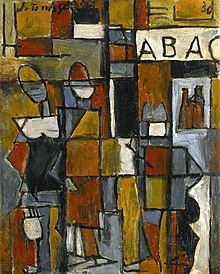 Joaquín Torres García, Figuras sobre una estrutura, 1930 | |
| Years active | 1930-1970 |
|---|---|
| Location | Uruguay |
| Influences | Anthropophagy, Cubism, Vibrationism, Rafael Barradas, Piet Mondrian, Geometric abstraction, Concrete Art, Primitivism |
| Influenced | Asociacion de Arte Constructivo, Taller Torres Garcia, Julio Alpuy |
Universal Constructivism (sometimes called Constructive Universalism) was a style of art created and developed by Joaquín Torres-García. Through the study and incorporation of basic geometric structure (Constructive) in the ancient and modern world creates the ability to create art that will be meaningful (Universal) to anyone who has viewed his artworks.[1] He took the principles of Constructivism that Russian artists had developed in the 1920s and had influenced De Stijl and Bauhaus movements, and integrated what he considered to be universal pictographs, such as those for sun, moon, man, and woman. The goal of this art movement was to seek for the definition of what it means to be American by dominating constructive art and the use of primitive art that was rooted in the traditions of the continent.[2] This style is best known for its synthesis of grid compositions and schematic signs.[1] When Torres-García started Taller Torres Garcia in 1944, many of the participants incorporated Universal Constructivism into their own work. And later, the style influenced North American artists, such as Adolph Gottlieb and Louise Nevelson.[3]
- ^ a b Perez-Barreiro, Gabriel (2007). The Geometry of Hope: Latin American Art from the Patricia Phelps de Cisneros Collection. Texas: Blanton Museum of Art.
- ^ Cite error: The named reference
:1was invoked but never defined (see the help page). - ^ Yau, John (10 January 2016). "Joaquín Torres-García: A Global Modernist Before His Time". Hyperallergic. Hyperallergic Media Inc. Retrieved 23 July 2019.
© MMXXIII Rich X Search. We shall prevail. All rights reserved. Rich X Search
